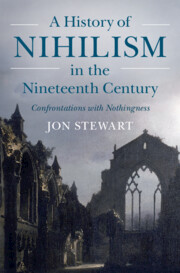Book contents
- A History of Nihilism in the Nineteenth Century
- A History of Nihilism in the Nineteenth Century
- Copyright page
- Dedication
- Contents
- Figures
- Preface
- Acknowledgments
- Introduction
- 1 Jean Paul’s Vision of Nihilism and Plea for the Doctrine of Immortality
- 2 Klingemann and the Absurdity of Nothingness in The Nightwatches
- 3 Nihilism in English Romanticism
- 4 Schopenhauer’s Theory of Human Suffering and Lack of Meaning
- 5 Büchner’s Account of the Reign of Terror as a Mirror of Human Existence
- 6 Poul Martin Møller’s Criticism of Hegelianism and the Danish Discussion of Nihilism
- 7 Kierkegaard and the Indefinability and Inexplicability of Death
- 8 Turgenev’s Portrait of a Nihilist
- 9 Nietzsche’s Vision of the Past and the Future of Nihilism
- 10 The Importance of Nihilism in the Nineteenth Century
- Selected Bibliography on Nihilism
- Name Index
- Subject Index
2 - Klingemann and the Absurdity of Nothingness in The Nightwatches
Published online by Cambridge University Press: 10 March 2023
- A History of Nihilism in the Nineteenth Century
- A History of Nihilism in the Nineteenth Century
- Copyright page
- Dedication
- Contents
- Figures
- Preface
- Acknowledgments
- Introduction
- 1 Jean Paul’s Vision of Nihilism and Plea for the Doctrine of Immortality
- 2 Klingemann and the Absurdity of Nothingness in The Nightwatches
- 3 Nihilism in English Romanticism
- 4 Schopenhauer’s Theory of Human Suffering and Lack of Meaning
- 5 Büchner’s Account of the Reign of Terror as a Mirror of Human Existence
- 6 Poul Martin Møller’s Criticism of Hegelianism and the Danish Discussion of Nihilism
- 7 Kierkegaard and the Indefinability and Inexplicability of Death
- 8 Turgenev’s Portrait of a Nihilist
- 9 Nietzsche’s Vision of the Past and the Future of Nihilism
- 10 The Importance of Nihilism in the Nineteenth Century
- Selected Bibliography on Nihilism
- Name Index
- Subject Index
Summary
Chapter 2 gives a reading of the obscure work The Nightwatches by the dramatist August Klingemann. The protagonist Kreuzgang is an odd outsider, highly critical of society around him. He is a night watchman, who goes out each night and observes people in their ordinary lives. Kreuzgang begins with some semblance of normalcy but then becomes increasingly disenchanted with the world until he finally fully embraces nihilism. Klingemann presents a mishmash of carefully framed scenes of horror and despair. It is a gallery of personalities with strange images and stories. People are portrayed as vain, pretentious, cruel, and hypocritical. The work raises the question of whether we, as human beings, are really anything beyond the social masks that we wear. Theater metaphors are often used to emphasize the idea there is nothing substantial in human life, but we are all playing meaningless roles, and then we die. Kreuzgang’s description of his fellow inmates in the insane asylum reveals an inverted world where what is usually accepted as reasonable by mainstream society is in fact irrational, and vice versa. The mad are the sane in an insane world.
Keywords
- Type
- Chapter
- Information
- A History of Nihilism in the Nineteenth CenturyConfrontations with Nothingness, pp. 64 - 98Publisher: Cambridge University PressPrint publication year: 2023

